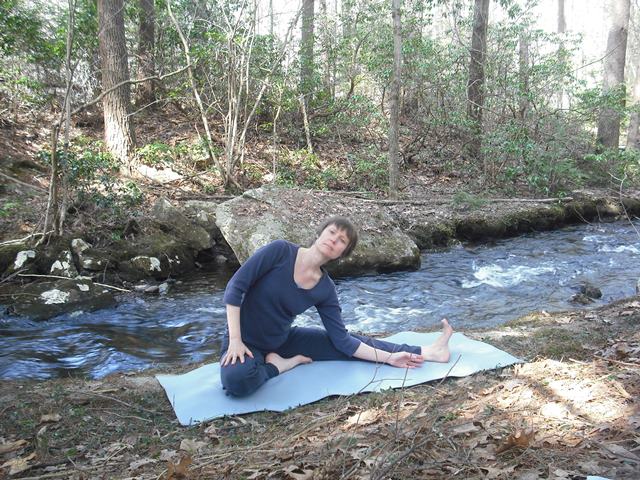This week’s post is offered by Éowyn Ahlstrom, who will be leading a mindful yoga series at the CFM this summer.
What is mindful yoga (or any kind of mindful movement) all about? I have been contemplating this question through practice and in discussions with fellow practitioners for years.
Folks in MBSR classes, for example, often ask why they are being encouraged to pay attention to their bodies, and what yoga has to do with reducing stress. The process of answering these questions must be, can only be, an experiential one.
It is an inside job, as they say.

Here’s an example from my own life. Last night, I could not fall asleep. It’s a familiar pattern, one that has come and gone and reappeared for two decades or more. After noticing how powerfully awake I was - sensing tightness of skin and muscles, busy-ness of mind - I rolled out of bed and slipped into the room next door, my dedicated place for practice.
Settling my back, head and feet onto the carpet, at first, I did not move at all, just attended to the breathing body and churning mind. Then, I began moving, stretching and listening inwardly. Rocking on the spine. Twisting. Forward bending. Child’s pose. Thinking quieted down while silent knowing established a steady, loving, moment-to-moment relationship with the sensations and experiences of bodily movement.
Knowing: rhythmic movements, breathing, stretching sensations, engagement of muscles, groundedness with the earth, spacious connection with the air. Before long, I felt the wonderful rest that is a quiet mind. After a half hour or so of practice, I returned to bed and fell quickly asleep. Of course, there’s no guarantee of this, but I find often enough that just knowing that is a remedy.
How great, right? When I mentioned to a friend recently that I know how to handle my body’s aches and pains to relieve or reduce them, she responded by saying, “I want to know what you know.”
Here is the thing: mindful yoga provides a doorway into a world many of us haven’t even considered entering, until we come to practice, the world of perceptive, wakeful embodiment. In my experience, the entire body is a receptive organ of perception. The sensations, vibrations, temperatures and movements are all part of perceiving. What I perceive through the body is an inner world, an inner universe. Mindful yoga is an approach to inner intimacy.
And so, if you, like my friend, want to know this world, you must learn from inside out. If you wish to know what it has to offer you, you can find out by learning and practicing mindful yoga.
For me, this journey is both joyful and liberating and unpleasant and frustrating. It’s all part of the process. Mindful yoga practice doesn’t require my body to be healthy or strong, or even to fall asleep on my preferred timeline, although it may support those conditions. It does require me to take a leap of faith, to trust that knowing in this non-conceptual, direct, somatic way is interesting enough and useful enough to bother with. It requires me to look for knowledge and understanding arising within, rather than outside.
Do you practice mindful movement of any kind? What are you learning? It would be a joy to engage in some discussion on the topic here.
